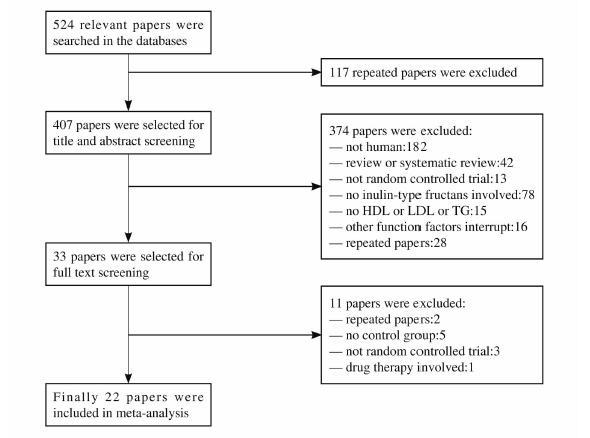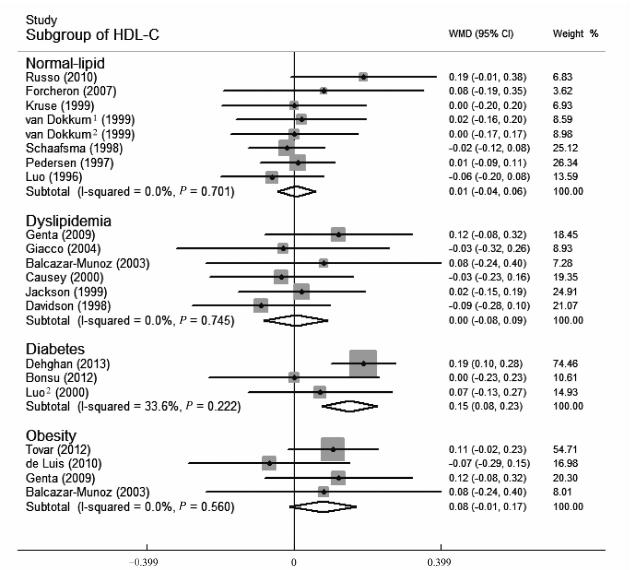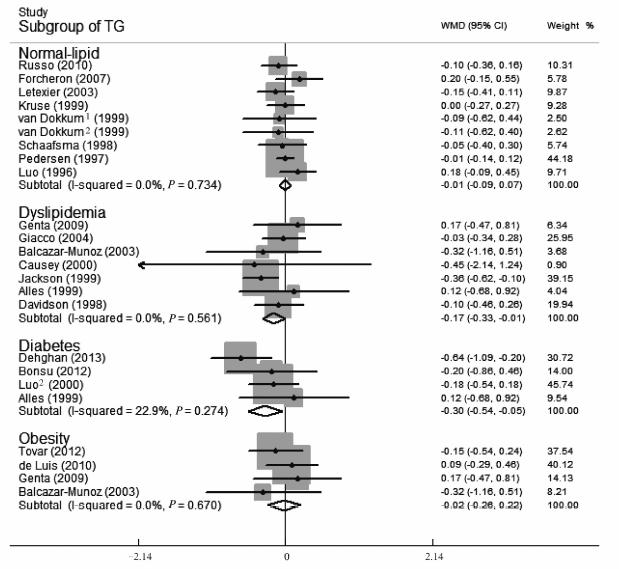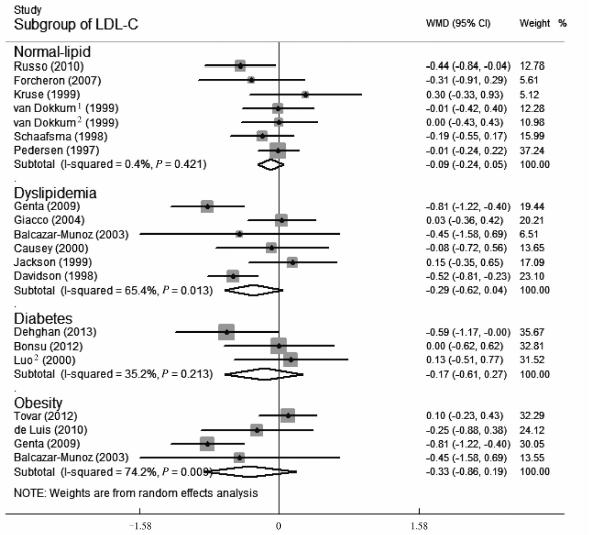2. 重庆医科大学公共卫生与管理学院流行病学教研室, 重庆 400016
2. Department of Epidemiology, School of Public Health and Management, Chongqing Medical University, Chongqing 400016, China
血清高密度脂蛋白胆固醇(HDL-C)水平降低,三酰甘油(TG)和低密度脂蛋白胆固醇(LDL-C)水平升高,称为血脂异常三联征[1]。该现象常存在于冠心病、糖尿病、肥胖等慢性代谢性疾病中[2, 3],多项流行病学和临床研究结果表明血脂异常三联征是动脉粥样硬化和冠心病患病的最重要危险因子之一[4, 5]。冠心病的死亡率占所有心血管疾病的一半,而心血管疾病在世界范围内死因居首位[6]。因此,调节与改善血脂异常三联征,在降低冠心病发病率和死亡率上显得至关重要。使用降血脂药物是目前针对血脂紊乱的主要治疗方式之一,但药物治疗的经济负担大,还有不良反应等缺点。美国国家胆固醇教育计划(NCEP)发布的关于成人胆固醇干预指南(ATPⅢ)指出,具有冠心病(cardiovascular disease,CVD)患病风险的血脂异常人群应通过治疗性生活方式改变(therapeutic lifestyle changes,TLC)改善血脂[7]。TLC是临床干预血脂异常的基本措施,其中膳食是调节血脂水平的基石。近年来,有关益生元调节血脂、防治慢性代谢性疾病的研究已成为热点。Wong等[8]研究显示了益生元的有效降胆固醇作用,de Luis等[9]研究表明摄食益生元可减少肥胖患者的心血管患病风险,Malaguarnera等[10]研究则表明益生元对非酒精性脂肪肝患者有保护作用。菊粉类果聚糖属于益生元,现已有多项研究报道了其和血脂的关系[11]。
菊粉类果聚糖是一种广泛存在于各种植物(如小麦、洋葱、香蕉、大蒜和韭菜等)中的天然果聚糖的混合物,果聚糖是果糖单元通过β-(2-1)链联接而成并以葡萄糖单元终止的碳水化合物,具有非黏性、可溶解、不消化和可发酵等特点,主要包括菊粉(inulin)和低聚果糖(oligofructose)[12]。美国FDA于2002年批准菊粉类果聚糖为“一般认为安全”(generally recognized as safe)食品成分。目前菊粉类果聚糖调节血脂的积极作用在一系列动物实验中得到证实[13, 14, 15, 16],但是,人体试验的结果却并不一致[17, 18, 19, 20]。本研究拟采用系统综述的方法,并用meta定量分析菊粉类果聚糖对人致动脉粥样硬化相关血脂HDL-C、TG和LDL-C水平的影响。 1 资料和方法 1.1 检索资源及检索策略
计算机检索外文数据库(PubMed、Embase)和中文数据库(CNKI、VIP、CBM和WanFang Datebases),检索时间从建库至2014年8月31日,检索主题为菊粉类果聚糖对血清TG、HDL-C和LDL-C水平的影响。
检索采用主题词与自由词结合的方式进行,英文检索式为:(fructo-oligosaccharide or fructo-oligose or inulin or oligofructose or fructan) AND (high density lipoprotein or HDL or low density lipoprotein or LDL or triglyceride or triacylglycerol or TG or TAG)。中文检索式为:(菊粉or低聚果糖or果寡糖) AND (甘油三酯or三酰甘油or高密度脂蛋白胆固醇or低密度脂蛋白胆固醇)。 1.2 文献筛选的纳入和排除标准
纳入标准:(1)研究对象无严重肾脏、心血管、甲状腺疾病及贫血,无遗传性血色素沉着症,近期未使用抗生素、调血脂药物或胰岛素治疗;(2)菊粉类果聚糖的种类和剂量明确;(3)研究类型为随机对照试验;(3)研究结果是关于菊粉类果聚糖对HDL-C或TG或LDL-C水平的影响。
排除标准:(1)重复文献;(2)有药物治疗或其他食品功能因子干扰;(3)结局指标不涉及三酰甘油、高密度脂蛋白胆固醇或低密度脂蛋白胆固醇中的任何一个或缺乏可提取数据;(4)非随机对照试验及病例对照研究、队列研究、描述性研究等;(5)综述、科普、观点类文章。按照纳入与排除标准,对检索得到的文献进行文题和摘要筛选;之后对有可能符合要求的文献进行全文筛选。上述两步筛选均由两名研究人员同步、独立进行,之后进行交叉核对,如有分歧,通过讨论或参考第三方意见达成一致,最终确定纳入的文献。 1.3 文献质量评价
为了得到准确真实的结果,按照Cochrane《系统评价员手册》中随机对照试验的4条质量评价标准,采用JADAD量表进行质量评价[21]:(1)随机方法是否正确;(2)是否采用分配隐藏,隐藏方案是否充分;(3)是否采用盲法,尤其是对测量者采用盲法;(4)有无失访或退出,如有失访或退出时,是否说明原因及是否采用意向治疗分析。最终质量评分得分4~7分者为高质量文献,0~3分为低质量文献。低质量文献不纳入评价。由两名研究者独立对文献进行评价,评价结果若出现分歧,由课题组进行讨论确定,必要时咨询相关专家意见。 1.4 数据提取
数据提取表经过试用并反复修改后最终确定。两名研究者按照预先制定的提取表独立提取纳入文献信息,提取主要内容包括:(1)文献基本信息,包括文题、作者及发表时间;(2)研究基本特征,包括研究对象、研究设计、试验物和试验时间;(3)主要结局指标,包括血高密度脂蛋白胆固醇、三酰甘油、低密度脂蛋白胆固醇等数据。提取结果由两名研究者交叉核对和验证。 1.5 统计学处理
采用Stata 11.0软件进行统计分析。定量合并分析菊粉类果聚糖对纳入研究的3种血脂HDL-C、TG和LDL-C水平的影响(分析所用数据为实验组研究前后均值差及其标准差和对照组研究前后均值差及其标准差,其中均值差的标准差运用两独立样本标准差合并公式计算)。根据研究对象基础血脂水平是否正常、糖尿病及肥胖患病情况,在所纳入研究中做了4个亚组分析:血脂正常组、血脂异常组、糖尿病组和肥胖组。在所有亚组中,针对这3种血脂分别计算其水平被影响的合并加权均数差(WMD)值及95%CI。
应用Q检验进行异质性检验,若I2>50%且P<0.05时,说明研究间异质性大,采用随机效应模型进行合并;否则(含I2<50%且P<0.05)选用固定效应模型。计算合并WMD值及95%CI,并进行Z检验,检验水准(α)为0.05。采用逐一排除法进行敏感性分析,以检测Meta分析的结果是否稳健。用 Egger’s 检验和 Begg’s 检验对发表偏倚进行分析。 2 结 果 2.1 纳入文献基本情况
检索后共得到524篇文献,文献筛选后,最终纳入22篇文献,共计23项随机对照研究(文献筛选流程见图 1)。共包括实验组413例,对照组409例。纳入研究中,9项研究以男性为研究对象,4项以女性为研究对象,其余10项两种性别均包括。研究对象包括正常人群、血脂异常人群、糖尿病人群,肥胖人群。研究设计类型包括交叉设计、平行设计或序贯设计。所有研究中,受试物有菊粉、低聚果糖、菊粉与低聚果糖的混合物。受试物作为甜味剂或加入饮料、奶油、巧克力酱、果汁、饼干、面食、早餐谷物、发酵乳制等中经口摄入,或以粉末形式单独摄入。纳入文献质量评价得分最低4分,最高5分。纳入各研究的基本情况见表l。
 | 图 1 文献筛选流程图 Fig 1 Literature search for meta-analysis |
| 表 1 纳入研究基本特征及文献质量评价 Tab 1 Characteristics and quality evaluation of included studies |
分析HDL-C、TG和LDL-C各指标的研究分别包含21项、23项和20项。纳入分析的所有研究对各血脂影响的结果不尽相同,经合并,得出菊粉类果聚糖影响人体血清HDL-C、TG、LDL-C水平的合并WMD 值及95%CI分别为0.05 (0.01,0.08) mmol/L、-0.08 (-0.14,-0.01) mmol/L、-0.16 (-0.25,-0.06) mmol/L,菊粉类果聚糖可使HDL-C水平升高0.05 mmol/L (P=0.008),TG和LDL-C水平分别降低0.08 mmol/L (P=0.017)和0.16 mmol/L (P=0.002)。这3个指标的异质性检验结果分别为I2=13.0%,P=0.290;I2=6.7%,P=0.370;I2=40.4%,P=0.032,所有指标纳入的各研究同质。 2.3 菊粉类果聚糖对血脂水平影响的亚组分析 2.3.1 HDL-C水平
结果(图 2)表明:血脂正常组、血脂异常组、糖尿病组和肥胖组的该指标被影响的合并WMD值及95%CI分别为0.01 (-0.04,0.06) mmol/L、0.00 (-0.08,0.09) mmol/L、0.15 (0.08,0.23) mmol/L和0.08 (-0.01,0.17) mmol/L,除了糖尿病组,菊粉类果聚糖对其他3组的该指标的影响均无统计学意义。各亚组所纳入研究同质。
 | 图 2 菊粉类果聚糖对HDL-C水平影响的亚组分析森林图 Fig 2 Meta-analysis of effect of inulin-fructans on HDL-C level in subgroups |
2.3.2 TG水平
结果(图 3)表明:血脂正常组、血脂异常组、糖尿病组和肥胖组的该指标被影响的合并WMD值及95%CI分别为 -0.01 (-0.09,0.07) mmol/L、-0.17 (-0.33,-0.01) mmol/L、-0.30 (-0.54,-0.05) mmol/L、-0.02 (-0.26,0.22) mmol/L,菊粉类果聚糖对血脂正常组和肥胖组该指标的影响无统计学意义。各亚组所纳入研究同质。
 | 图 3 菊粉类果聚糖对TG水平影响的亚组分析森林图 Fig 3 Meta-analysis of effect of inulin-fructans on TG level in subgroups |
2.3.3 LDL-C水平
结果表明(图 4):血脂正常组、血脂异常组、糖尿病组和肥胖组的该指标被影响的合并WMD值及95%CI分别为-0.09 (-0.24,0.05) mmol/L、-0.29 (-0.62,0.04) mmol/L、-0.17 (-0.61,0.27) mmol/L和-0.33 (-0.86,0.19) mmol/L,菊粉类果聚糖对所有亚组的该指标 的影响均无统计学意义。血脂正常组和糖尿病组所纳入研究同质,而血脂异常组和肥胖组所纳入各研 究间有明显异质性。合成森林图只能采用一种效应模型,因此该指标的亚组分析均采用随机效应模型,这对两个同质亚组的合并结果没有实质影响。
 | 图 4 菊粉类果聚糖对LDL-C水平影响的亚组分析森林图 Fig 4 Meta-analysis of effect of inulin-fructans on LDL-C level in subgroups |
针对3种不同血脂,分别将每种血脂纳入的总文献逐一排除后分析,结果发现各血脂水平被影响的结果均无实质性改变。 2.5 发表偏倚评价
结果显示:HDL(Egger’s test,P=0.26; Begg’s test,P=0.74),TG(Egger’s test,P=0.46; Begg’s test,P=0.43),LDL(Egger’s test,P=0.82; Begg’s test,P=0.97),各血脂指标均不存在明显发表偏倚。 3 讨 论
本研究旨在综合国内外研究结果的基础上,采用meta分析的方法,综合评估菊粉类果聚糖对致动脉粥样硬化相关血脂的影响,并且对几类特殊人群做了亚组分析。本研究最终纳入22篇文献,共23项研究,研究时间范围从1996年到2013年;平均干预剂量为菊粉(14.0±6.3) g/d(7~34 g/d),低聚果糖(14.7±4.0) g/d (9.4~20 g/d);试验周期最短28 d,最长180 d,平均(49±39) d,足够观察膳食 对血脂的影响效果[40]。基本上没有研究运用随机分配隐藏,导致纳入研究的质量受影响,所以临床上应该多开展更高质量的相关随机对照研究。
本研究纳入的23项研究中,有12项研究表明菊粉类果聚糖对致动脉粥样硬化相关血脂有显著影响,另外11项则未见显著影响。合并所有研究分析显示,菊粉类果聚糖可使人血清HDL-C水平升高0.05 mmol/L,同时使TG和LDL-C水平分别降低0.08 mmol/L和0.16 mmol/L。尽管纳入各研究的 设计类型及受试物添加入食物种类、量、试验周期均不一致,但是分析结果显示各研究同质。本研究针 对血脂正常人群、血脂异常人群、糖尿病人群和肥胖人群进行了亚组分析。亚组分析结果显示,只有血脂异常组的TG水平降低0.17 mmol/L,糖尿病组的HDL-C水平升高0.15 mmol/L 、TG水平降低0.30 mmol/L,其他结果均无统计学意义。
总合并分析结果表明HDL-C水平显著升高,通过亚组分析,其水平的升高仅见于糖尿病组,并且升高幅度比总合并结果大得多。总合并分析结果表明TG水平显著降低0.08 mmol/L,在亚组分析中,只有血脂异常和糖尿病组该指标降低,并且前者降低幅度约为总合并分析结果的2倍,后者大概达4倍。而且这两个指标的总合并分析、各亚组分析所纳入研究均同质。结果充分说明,菊粉类果聚糖对血脂异常和糖尿病患者血脂调节作用更加明显。血脂异常患者本身是动脉粥样硬化和冠心病患病的高危人群,而糖尿病人群由于常伴随着血脂异常,更易并发该疾病,导致死亡率增高[17]。因此,糖尿病人群更需要积极治疗血脂异常[41]。本研究显示,菊粉类果聚糖既可使糖尿病患者血清TG水平降低,还能使其HDL-C水平显著升高。因此每日摄食菊粉类果聚糖可成为血脂异常和糖尿病患者预防动脉粥样硬化和冠心病发生的有利因素之一。 值得注意的是,虽然合并所有研究分析(固定和随机两种效应模型)LDL-C水平得出的结果是显著降低,但该指标在各亚组分析中均无统计学意义。在LDL-C的亚组分析中,血脂异常组和肥胖组所纳入的各研究间存在明显异质性,对这两组分析结果产生了质的影响。
吴婷等[42]开展的菊粉类果聚糖对血脂影响的系统评价,研究了总胆固醇,而本研究分析了 HDL-C 和LDL-C。低密度脂蛋白的作用是从肝脏携带胆固醇到冠状动脉,可造成过多的胆固醇在血管壁上存积,引起动脉粥样硬化,而HDL能将血管壁多余的胆固醇运送回肝脏进行代谢,从而保护血管免受侵害。本研究对这两个指标进行分析,能清楚地发现菊粉类果聚糖对动脉粥样硬化的影响,因此比起研究总胆固醇的意义更大。但是本研究结果显示,部分亚组的HDL-C水平升高,而LDL-C水平无改变。目前有关菊粉类果聚糖影响HDL-C或LDL-C的机制研究很少,尚需这方面的实验研究进一步探索。一系列动物实验只是解释了菊粉类果聚糖降总胆固醇的原因,但都没有足够证据做出确定的结论,而且这些研究表明菊粉类果聚糖的降胆固醇作用不太一致[12, 43, 44]。本研究结果从另一个角度也说明菊粉类果聚糖降胆固醇作用不够明确,与已有研究大致相符。
目前的研究表明,菊粉类果聚糖降三酰甘油的机制可能是其在小肠不被消化,到达结肠被发酵产生短链脂肪酸(SCFA),从而减少三酰甘油的合成[45]。一系列动物实验显示,菊粉类果聚糖降TG的效果一致,主要是因为肝脏脂肪酸的合成受到阻碍,而阻碍脂肪酸合成通路在人体中并不活跃,除非其膳食主要是碳水化合物[46]。因此在人体研究中降TG效果的不一致,可能主要是由于膳食背景不同造成的。本研究TG水平的降低只发生在部分亚组中,这可能与上述原因有一定的关系,但是这方面的机制还是需要更多的实验研究进一步证实。
在治疗血脂异常的临床意义上,菊粉类果聚糖对血脂的影响效果不及一些专门调节血脂的药物,但其效果和一些其他膳食或行为干预相仿[47, 48, 49, 50]。且其可作为食品添加剂加入各种膳食中,可取代部分脂肪,口感好,比起药物和其他膳食干预,依从性更好。因此,每日摄食约14 g菊粉类果聚糖可改善血脂,还可避免药物不良反应。
Brighenti[51]也做过膳食果聚糖对血三酰甘油的meta分析,该研究检索的是2005年以前的文献,研究样本共290例。而本研究全面检索了PubMed、Embase两个英文数据库,知网、维普、万方、CBM 4个中文数据库,检索时间从建库至2014年8月31日,样本量达822例。此外,本研究关注于致动脉粥样硬化相关3种主要血脂,并进行了血脂正常、血脂异常、糖尿病和肥胖等4种特殊人群的亚组分析。
当然,本研究仍存在一些不足。首先,纳入的随机对照研究基本未实施随机分配隐藏,文献质量评分多为4分,只有3篇文献评分为5分,所以纳入文献的质量有一定限制,可能会在某种程度上影响结果。其次,进行亚组分析时,由于某些文献未说明研究对象血脂是否正常,剔除这些研究可能导致血脂正常组和血脂异常组的分析结果不太准确。最后,糖尿病和肥胖的亚组分析可纳入文献数较少,可能对结果的解释会有一定的影响。
综上所述,菊粉类果聚糖对致动脉粥样硬化相关血脂有积极的影响,特别对血脂异常和糖尿病患者的血脂改善作用更加明显。因此,临床医生可特别建议此类患者通过每日摄食菊粉类果聚糖14 g左右来预防和治疗其血脂异常,从而在一定程度上达到减少动脉粥样硬化和冠心病患病风险的目的。 4 利益冲突
所有作者声明本文不涉及任何利益冲突。
| [1] | Gotto A M Jr. Evolving concepts of dyslipidemia, atherosclerosis, and cardiovascular disease: the Louis F. Bishop Lecture[J]. J Am Coll Cardiol, 2005, 46:1219-1224. |
| [2] | Temelkova-Kurktschiev T, Hanefeld M. The lipid triad in type 2 diabetes-prevalence and relevance of hypertriglyceridaemia/low high-density lipoprotein syndrome in type 2 diabetes[J]. Exp Clin Endocrinol Diabetes, 2004, 112:75-79. |
| [3] | Bays H E, Toth P P, Kris-Etherton P M, Abate N, Aronne L J, Brown W V, et al. Obesity, adiposity, and dyslipidemia: a consensus statement from the National Lipid Association[J]. J Clin Lipidol, 2013, 7:304-383. |
| [4] | Cabrera M, Sánchez-Chaparro M, Valdivielso P, Quevedo-Aguado L, Catalina-Romero C, Fernández-Labandera C, et al. Prevalence of atherogenic dyslipidemia: Association with risk factors and cardiovascular risk in Spanish working population. "ICARIA" study[J]. Atherosclerosis, 2014, 235:562-569. |
| [5] | Ahmad S, Hossain M M, Anas M. Lipid triad: an important predictor of dyslipidemia related disorders and its therapeutic intervention[J]. J Glycomics Lipidomics, 2013, e114. |
| [6] | DiRienzo D B. Effect of probiotics on biomarkers of cardiovascular disease: implications for heart-healthy diets[J]. Nutr Rev, 2014, 72:18-29. |
| [7] | 胡大一. NCEP-ATPⅢ报告——关于血脂异常干预的重要新建议[J]. 中国医刊, 2004, 39:62. |
| [8] | Wong J M, Kendall C W, de Souza R, Emam A, Marchie A, Vidgen E, et al. The effect on the blood lipid profile of soy foods combined with a prebiotic: a randomized controlled trial[J]. Metabolism, 2010, 59:1331-1340. |
| [9] | De Luis D A, De la Fuente B, Izaola O, Conde R, Gutierrez S, Morillo M, et al. Double blind randomized clinical trial controlled by placebo with an alpha linoleic acid and prebiotic enriched cookie on risk cardiovascular factor in obese patients[J]. Nutr Hosp, 2011, 26:827-833. |
| [10] | Malaguarnera M, Vacante M, Antic T, Giordano M, Chisari G, Acquaviva R, et al. Bifidobacterium longum with fructo-oligosaccharides in patients with non alcoholic steatohepatitis[J]. Dig Dis Sci, 2012, 57:545-553. |
| [11] | Ooi LG, Liong M T. Cholesterol-lowering effects of probiotics and prebiotics: A review of in vivo and in vitro findings[J]. Int J Mol Sci, 2010, 11:2499-2522. |
| [12] | Roberfroid M B. Introducing inulin-type fructans[J]. Br J Nutr, 2007, 93(S1):S13. |
| [13] | Agheli N, Kabir M, Berni-Canani S, Petitjean E, Boussairi A, Luo J, et al. Plasma lipids and fatty acid synthase activity are regulated by short-chain fructo-oligosaccharides in sucrose-fed insulin-resistant rats[J]. J Nutr, 1998, 128:1283-1288. |
| [14] | Busserolles J, Gueux E, Rock E, Demigné C, Mazur A, Rayssiguier Y. Oligofructose protects against the hypertriglyceridemic and pro-oxidative effects of a high fructose diet in rats[J]. J Nutr, 2003, 133:1903-1908. |
| [15] | Rozan P, Nejdi A, Hidalgo S, Bisson J F, Desor D, Messaoudi M. Effects of lifelong intervention with an oligofructose-enriched inulin in rats on general health and lifespan[J]. Br J Nutr, 2008, 100:1192-1199. |
| [16] | Rault-Nania M H, Gueux E, Demougeot C, Demigne C, Rock E, Mazur A. Inulin attenuates atherosclerosis in apolipoprotein E-deficient mice[J]. Br J Nutr, 2006, 96:840-844. |
| [17] | Dehghan P, Pourghassem Gargari B, Asgharijafarabadi M. Effects of high performance inulin supplementation on glycemic status and lipid profile in women with type 2 diabetes: a randomized, placebo-controlled clinical trial[J]. Health Promot Perspect, 2013, 3:55-63. |
| [18] | Kruse H P, Kleessen B, Blaut M. Effects of inulin on faecal bifidobacteria in human subjects[J]. Br J Nutr, 1999, 82:375-382. |
| [19] | Pedersen A, Sandstrom B, Van Amelsvoort J M. The effect of ingestion of inulin on blood lipids and gastrointestinal symptoms in healthy females[J]. Br J Nutr, 1997, 78:215-222. |
| [20] | Bonsu N, Johnson S. Effects of inulin fibre supplementation on serum glucose and lipid concentration in patients with type 2 diabetes[J]. Int J Diabetes Metab, 2012, 21:80-86. |
| [21] | Jadad A R, Moore R A, Carroll D, Jenkinson C, Reynolds D J, Gavaghan D J, et al. Assessing the quality of reports of randomized clinical trials: is blinding necessary?[J]. Control Clin Trials, 1996,17:1-12. |
| [22] | Tovar A R, Caamano Mdel C, Garcia-Padilla S, Garcia O P, Duarte M A, Rosado J L. The inclusion of a partial meal replacement with or without inulin to a calorie restricted diet contributes to reach recommended intakes of micronutrients and decrease plasma triglycerides: a randomized clinical trial in obese Mexican women[J]. Nutr J, 2012, 11:44. |
| [23] | De Luis D A, De la Fuente B, Izaola O, Conde R, Gutierrez S, Morillo M, et al. Randomized clinical trial with a inulin enriched cookie on risk cardiovascular factor in obese patients[J]. Nutr Hosp, 2010, 25:53-59. |
| [24] | Russo F, Riezzo G, Chiloiro M, De Michele G, Chimienti G, Marconi E, et al. Metabolic effects of a diet with inulin-enriched pasta in healthy young volunteers[J]. Curr Pharm Des, 2010, 16:825-831. |
| [25] | Genta S, Cabrera W, Habib N, Pons J, Carillo I M, Grau A, et al. Yacon syrup: Beneficial effects on obesity and insulin resistance in humans[J]. Clin Nutr, 2009, 28:182-187. |
| [26] | Forcheron F, Beylot M. Long-term administration of inulin-type fructans has no significant lipid-lowering effect in normolipidemic humans[J]. Metabolism, 2007, 56:1093-1098. |
| [27] | Daubioul C A, Horsmans Y, Lambert P, Danse E, Delzenne N M. Effects of oligofructose on glucose and lipid metabolism in patients with nonalcoholic steatohepatitis: results of a pilot study[J]. Eur J Clin Nutr,2005,59:723-726. |
| [28] | Giacco R, Clemente G, Luongo D, Lasorella G, Fiume I, Brouns F, et al. Effects of short-chain fructo-oligosaccharides on glucose and lipid metabolism in mild hypercholesterolaemic individuals[J]. Clin Nutr, 2004, 23:331-340. |
| [29] | Balcazar-Munoz B R, Martinez-Abundis E, Gonzalez-Ortiz M. Effect of oral inulin administration on lipid profile and insulin sensitivity in subjects with obesity and dyslipidemia[J]. Rev Med Chil, 2003, 131:597-604. |
| [30] | Letexier D, Diraison F, Beylot M. Addition of inulin to a moderately high-carbohydrate diet reduces hepatic lipogenesis and plasma triacylglycerol concentrations in humans[J]. Am J Clin Nutr, 2003, 77:559-564. |
| [31] | Causey J L, Feirtag J M, Gallaher D D, Tungland B C, Slavin J L. Effects of dietary inulin on serum lipids, blood glucose and the gastrointestinal environment in hypercholesterolemic men[J]. Nutr Res, 2000, 20:191-201. |
| [32] | Luo J, Van Yperselle M, Rizkalla S W, Rossi F, Bornet F R, Slama G. Chronic consumption of short-chain fructooligosaccharides does not affect basal hepatic glucose production or insulin resistance in type 2 diabetics[J]. J Nutr, 2000, 130:1572-1577. |
| [33] | Alles M S, De Roos N M, Bakx J C, Van de Lisdonk E, Zock P L, Hautvast J G. Consumption of fructooligosaccharides does not favorably affect blood glucose and serum lipid concentrations in patients with type 2 diabetes[J]. Am J Clin Nutr, 1999,69:64-69. |
| [34] | Brighenti F, Casiraghi M C, Canzi E, Ferrari A. Effect of consumption of a ready-to-eat breakfast cereal containing inulin on the intestinal milieu and blood lipids in healthy male volunteers[J]. Eur J Clin Nutr,1999,53: 726-733. |
| [35] | Jackson K G, Taylor G R, Clohessy A M, Williams C M. The effect of the daily intake of inulin on fasting lipid, insulin and glucose concentrations in middle-aged men and women[J]. Br J Nutr, 1999, 82:23-30. |
| [36] | Van Dokkum W, Wezendonk B, Srikumar T, Van den Heuvel E. Effect of nondigestible oligosaccharides on large-bowel functions, blood lipid concentrations and glucose absorption in young healthy male subjects[J]. Eur J Clin Nutr, 1999,53:1-7. |
| [37] | Davidson M H, Maki K C, Synecki C, Torri S A, Drennan K B. Effects of dietary inulin on serum lipids in men and women with hypercholesterolemia[J]. Am J Clin Nutr,1998,18:503-517. |
| [38] | Schaafsma G, Meuling W, Van Dokkum W, Bouley C. Effects of a milk product, fermented by Lactobacillus acidophilus and with fructo-oligosaccharides added, on blood lipids in male volunteers[J]. Eur J Clin Nutr, 1998, 52:436-440. |
| [39] | Luo J, Rizkalla S W, Alamowitch C, Boussairi A, Blayo A, Barry J L, et al. Chronic consumption of short-chain fructooligosaccharides by healthy subjects decreased basal hepatic glucose production but had no effect on insulin-stimulated glucose metabolism[J]. Am J Clin Nutr, 1996, 63:939-945. |
| [40] | Mensink R P, Aro A, Den Hond E, German J B, Griffin B A, ten Meer H U, et al. PASSCLAIM-Diet-related cardiovascular disease[J]. Eur J Nutr, 2003, 42Suppl 1:Ⅰ6-Ⅰ27. |
| [41] | Kumar A, Singh V. Atherogenic dyslipidemia and diabetes mellitus: what’s new in the management arena? [J]. Vasc Health Risk Manag, 2010, 6:665. |
| [42] | 吴 婷,杨月欣,张立实,韩军花. 菊粉类果聚糖对血甘油三酯和总胆固醇的影响——系统评价初探[J]. 卫生研究,2010,39:172-176. |
| [43] | Mortensen A, Poulsen M, Frandsen H. Effect of a long-chained fructan Raftiline HP on blood lipids and spontaneous atherosclerosis in low density receptor knockout mice[J]. Nutr Res, 2002, 22:473-480. |
| [44] | Agheli N, Kabir M, Berni-Canani S, Petitjean E, Boussairi A, Luo J, et al. Plasma lipids and fatty acid synthase activity are regulated by short-chain fructo-oligosaccharides in sucrose-fed insulin-resistant rats[J]. J Nutr, 1998, 128:1283-1288. |
| [45] | Yeo S K, Ooi L G, Lim T J, Liong M T. Antihypertensive properties of plant-based prebiotics[J]. Int J Mol Sci, 2009, 10:3517-3530. |
| [46] | Williams C M, Jackson K G. Inulin and oligofructose: effects on lipid metabolism from human studies[J]. Br J Nutr, 2007, 87(S2):S261. |
| [47] | Anderson J W, Randles K M, Kendall C W, Jenkins D J. Carbohydrate and fiber recommendations for individuals with diabetes: a quantitative assessment and meta-analysis of the evidence[J]. J Am Coll Nutr,2004, 23: 5-17. |
| [48] | Zhan S, Ho S C. Meta-analysis of the effects of soy protein containing isoflavones on the lipid profile[J]. Am J Clin Nutr, 2005, 81:397-408. |
| [49] | Kelley G A, Kelley K S, Tran Z V. Aerobic exercise and lipids and lipoproteins in women: a meta-analysis of randomized controlled trials[J]. J Womens Health (Larchmt), 2004, 13:1148-1164. |
| [50] | Kelley G A, Kelley K S. Aerobic exercise and lipids and lipoproteins in men: a meta-analysis of randomized controlled trials[J]. J Mens Health Gend, 2006, 3:61-70. |
| [51] | Brighenti F. Dietary fructans and serum triacylglycerols: a meta-analysis of randomized controlled trials[J]. J Nutr, 2007, 137(11 Suppl):2552S-2556S. |
 2015, Vol. 36
2015, Vol. 36


